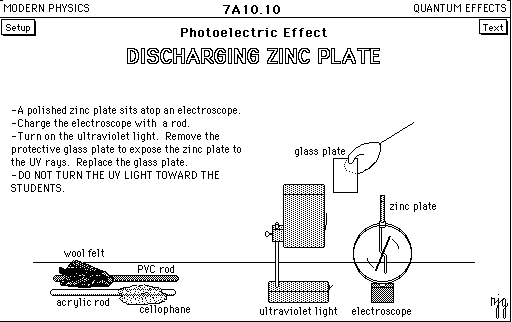
WARNING: UV light is dangerous to the eyes.
Make sure that you don't aim it towards the students, and that you don't look directly at it.
Equipment:
- Braun electroscope - shelf 14A
- zinc plate with banana plug; steel wool - shelf 11E
- Macalaster ultraviolet light source - shelf 12B
- PVC rod and fur; acrylic rod and silk - shelf 14E
Theory: The photons in UV light have an energy which is
larger than the work function of electrons in metals. UV light can therefore be
used to liberate electrons from a metal, demonstrating the photoelectric
effect.
Description: Rub the zinc with the steel wool to remove
any oxide, and to expose the metal. Remove the round plate from the top
of the electroscope, and replace it with the zinc.
Then you can show three things:
- Give the electroscope a negative charge using the PVC rubbed with fur.
With the glass shield removed from the UV light source, shine UV light on
the zinc. This will discharge the electroscope.
- Again, give the electroscope a negative charge. Replace the shield on the
electroscope, which will absorb most of the UV. Show that the electroscope is
not discharged when exposed to this light.
- Give the electroscope a positive charge, using the acrylic rubbed with
silk. Show that the electroscope is not discharged when exposed to the
UV light, even if the glass shield is removed from the light.
Setup time: 5 minutes.
References: (available in the demo room)
- Meiners, "Physics Demonstration Experiments",
38-2.1, p. 1169.
- Sutton, "Demonstration Experiments in Physics", A-89, p. 488.
- Carpenter and Minnix, "The Dick and Rae Physics Demo Notebook", S-095.
- Rueckner and Steel, "The Demonstrative Physicist's Companion", QR1.6.